RouteSavvy Quick Start Guide
This guide covers everything needed to get started quickly and easily with RouteSavvy, including:
- How to format spreadsheets of customer addresses.
- How to upload spreadsheets to RouteSavvy to create single or multiple routes simultaneously.
- How to dispatch your routes in mere minutes.
- How to back up your RouteSavvy project.
Formatting Your Spreadsheet
Data formatting is simple with RouteSavvy. For a sample spreadsheet that shows how to format your data, please download the .CSV or the .XLSX files here. Your spreadsheet will need to be in one of these two file formats. Please notice on the sample that the first row is the header row, and each column has a header that tells RouteSavvy how to handle that column. Each row after the header row is one location.
Good formatting is the easiest way to ensure your experience with RouteSavvy goes smoothly.
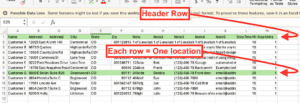
The default fields include Name, Address1, Address2, City, State, Zip, Country, Note, Note2, Note3, Note4, Note5 Full Address, Stop Time Minutes, Folder, Latitude, and Longitude.
The preferred address format is “Address1, Address2, City, State, Zip, Country“. Use abbreviations for all addresses, for example, “CT” instead of “Court”, or “AVE” instead of “Avenue” and always use the two-letter abbreviation for the state or province, since RouteSavvy will read and geocode the address more accurately this way. An address OR latitude and longitude is required to map and route a location. While an address can often be found with only Address1 and ZIP, always include as much information as is available to avoid any confusion.
You may use Full Address as a replacement for the segmented address fields Address1 + Address2 + City + State + Zip + Country. For example: “12023 East Arapahoe RD Unit 140, Centennial, CO, 801123815, USA”. This means that if you have your addresses in separate columns, or if your addresses are in one single column, RouteSavvy can still read it, you do not have to change the format of your spreadsheet.
Latitude and Longitude should only be used in specialty scenarios where an address is unavailable. Examples of applications that may require latitude and longitude include utilities maintenance or rural applications where the driver or technician is not being sent to an address. If addresses are available for your locations, please do not include any Latitude and Longitude in your spreadsheet for RouteSavvy.
We recommend using Stop Time, which is the number of minutes you expect the driver or technician will need to service each location. While Stop Time is optional, if you do not enter a stop time, RouteSavvy will only be able to calculate the drive time of the routes, not how long it will take to service them. To add Stop Time to your spreadsheet, simply use any empty column and type “Stop Time” in the header row. In the Stop Time column, enter the number of minutes you expect the driver or technician will need to service each location. Stop Time can only be an integer, so use only whole, non-decimal, non-fractional, positive numbers. This number can vary by location, and you can change it later.
There are 5 optional notes fields (Note, Note 2, Note 3, Note 4, and Note 5) that can be used for any information you want, such as phone number, email, special instructions, or product number. These fields should be used to keep helpful information at your driver’s or technician’s fingertips in the field. The notes fields on a route are typically always visible to the driver in the field; we recommend limiting this information to things that are needed for field operations.
Common Issues:
Many spreadsheets contain empty rows at the top. Often, these rows are helpful to the person using the spreadsheet, but they will only confuse any software that tries to import your data.
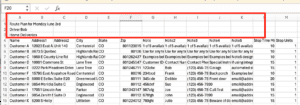
In the case above, you would need to delete the 3 highlighted rows, so that your Header row is Row 1. You can simply highlight these rows, right-click, and then click “Delete”. After that, save your spreadsheet and it will be ready to upload, as long as the rest of the formatting is correct. Lastly, avoid any empty rows in the middle of your spreadsheet, RouteSavvy will read each empty row as a bad address.
If you experience any issues with formatting or uploading your data, please email us at support@routesavvy.com and attach your spreadsheet. We are always happy to take a look, make a few quick changes, and send it right back to you.
There are multiple ways to create a Quick Route.
The first way is to drag your file into the gray box (1) on the “Welcome to RouteSavvy” dialog box when the RouteSavvy page first opens. This will begin the data import process. The second way (2) is to click “Choose File” and browse to the location of your spreadsheet. Once the spreadsheet is selected, click on the large green “Create Route” button.
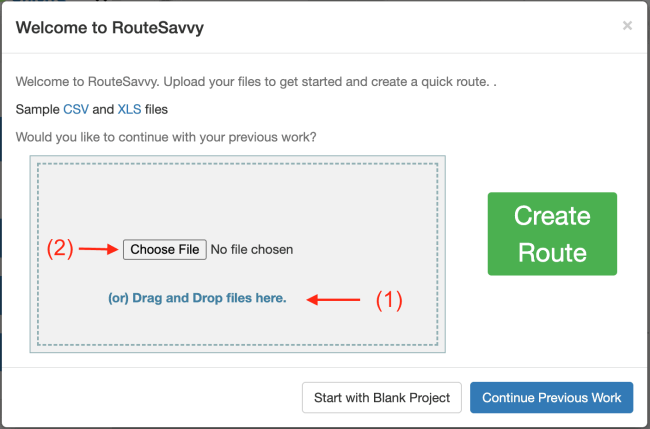
You can also create a Quick Route from the Route Planner tab using the “Quick Route” button (3). This activates the same dialog box with the large “Create Route” button, and it functions exactly the same way.
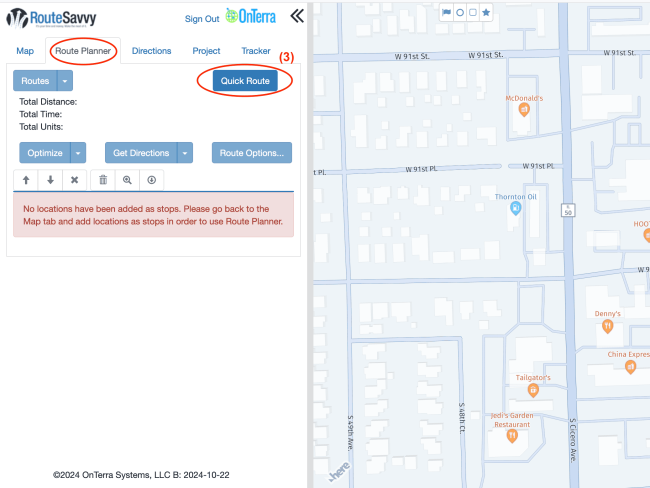
If you choose an Excel file with multiple tabs, the following dialog appears “Data Upload – Choose the worksheet” which allows you to choose which tab of your worksheet you want to upload. RouteSavvy can only upload one tab at a time.

The following dialog box, “Confirm Stop Address” allows you to choose which columns to use from your spreadsheet for the Address1, City, and ZIP columns, or to use one column for the Full Address. This is an “either/or” decision, so you will use either the “Address, City, and ZIP” format or you will use “Full Address”.
If you have formatted your spreadsheet according to the format given in our sample .CSV and .XLSX files, then you will not have to choose any columns here and RouteSavvy will simply show this dialog box for a moment and proceed to the next dialog box.
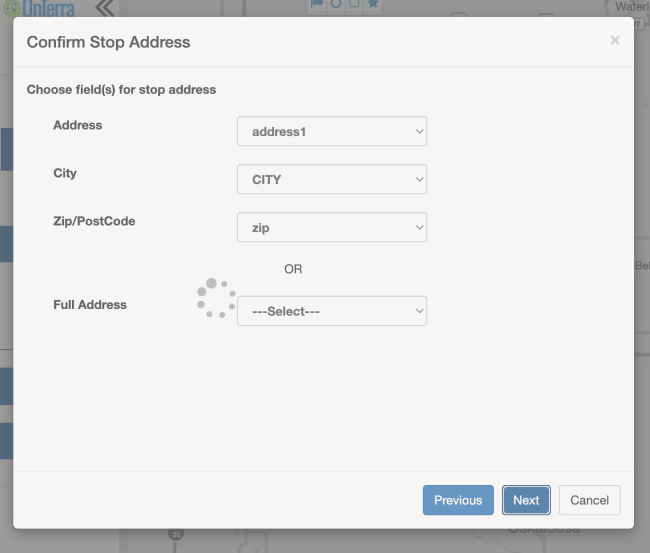
Geocoding Results
This dialog box is where RouteSavvy returns address matches. If you see the red error message at the top that says “If the Match Type is not Address…” then you will need to scroll through the list to find which address(es) were not found.
To resolve any errors, you can choose to delete the address for now and enter it later, or you can click the edit button and correct the address now. If you do not see the red “Match Type” error, this means all of your addresses are good.
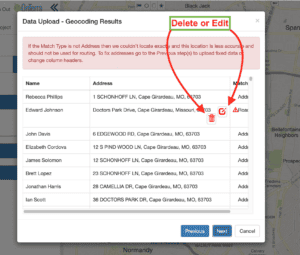
Route Options
In the next dialog, “Route Options”, you can choose a name for your route, and the default start and end. This default start and end will be pre-populated in the routes you are creating now, as well as any future route you create until you change it.
To make a round trip, use the same address for both the start and end. RouteSavvy also allows for an end-to-end route, simply choose the desired start and the desired end. Please note that you can search in the “Route Start Location” and the “Route End Location” boxes using an address, or by using points of interest, such as “LaGuardia Airport”.
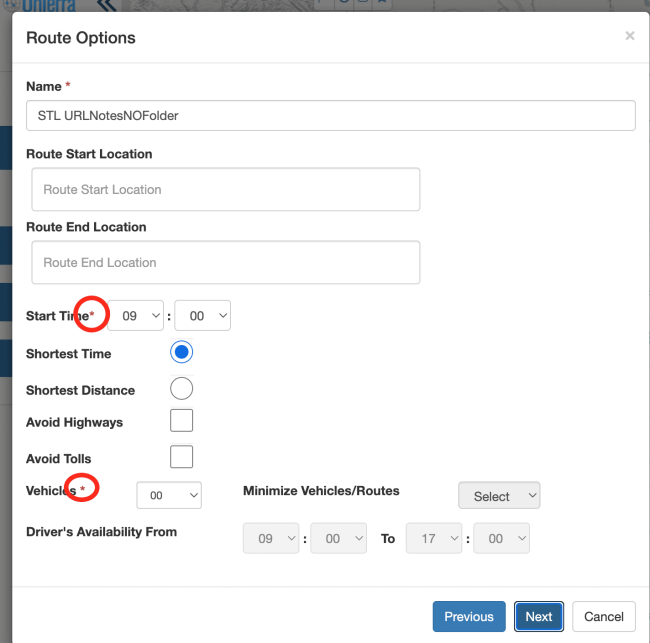
You can also choose:
- the default start time
- whether to optimize the route(s) by the shortest time or by the shortest distance
- whether to avoid highways or tolls.
The “shortest distance” optimization is typically only advisable if you have a vehicle that cannot reach the speed limit, e.g. a piece of heavy equipment that can only travel up to 25 miles per hour.
“Driver’s Availability” is the start and end time for your drivers. Please note that all times are in 24-hour format, so 5:00 pm is 17:00.
“Vehicles” is the number of vehicles you have available to complete the routes, or it can simply be “the number of routes you want to create from this spreadsheet”. For example, you could upload a week’s worth of stops in one spreadsheet and set Vehicles to 5 and it would give routes for an entire work week for one vehicle (Monday through Friday).
“Minimize Vehicles/Routes” is a setting that will allow RouteSavvy to use fewer vehicles if possible. For example, if you have 8 vehicles available but don’t want to use all of them unless they are needed, check the Minimize Vehicles option. RouteSavvy might find that only 6 routes are needed to complete all of the stops, and it will only create as many routes as you need.
If you do not use the Minimize Vehicles option, then RouteSavvy will spread your stops evenly among the number of vehicles you select.
Please Note: if you accidentally select “Minimize Vehicles”, it may seem like you cannot deselect it. Simply change the number of vehicles, and it will deselect “Minimize Vehicles”.
Also Please Note: the standard RouteSavvy license includes five multi-route optimizations per day. This is a premium feature, so if you need to use more than five multi-route optimizations per day, please contact us for pricing. You can plan unlimited single routes.
Once you have made all of your choices, press “Next”. RouteSavvy will then send your addresses to the Route Planner tab and optimize them. You can view and edit all of the routes from the Route Planner tab.
If you do not have enough drivers available to service all your stops, then you will see the “Some Stops are not routed” message.
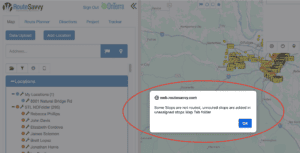
If this is the case, scroll down the Map tab to find a folder named “Unrouted Stops”. You may need to add another Vehicle, expand driver availability, or service these stops another day, according to your business needs.
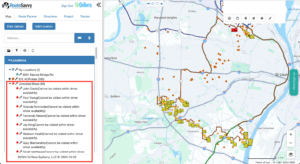
Dispatch
On the Directions tab, use the “Mobile” button to send a route to the RouteSavvy Mobile App (please see this article for a detailed guide on how to set up the Mobile App).
Once the Mobile App is set up for use, go to the Directions tab (1) and click the “Mobile” button (2). Scroll to the bottom of the “Send to Mobile” dialog box (3), then select the mobile device you wish to send the route to (4). Lastly, press “Next” and RouteSavvy will display a confirmation message that the route was sent. The route will be available on the mobile device in a matter of seconds.
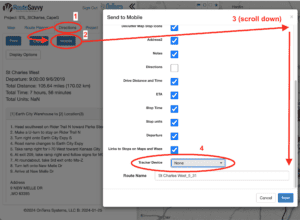
Backup
Lastly, the Project tab allows you to back up your work to your hard drive by clicking on “Save Project File” and to change the RouteSavvy global settings, such as route start time, and default start and end, by clicking on “Edit Settings”.
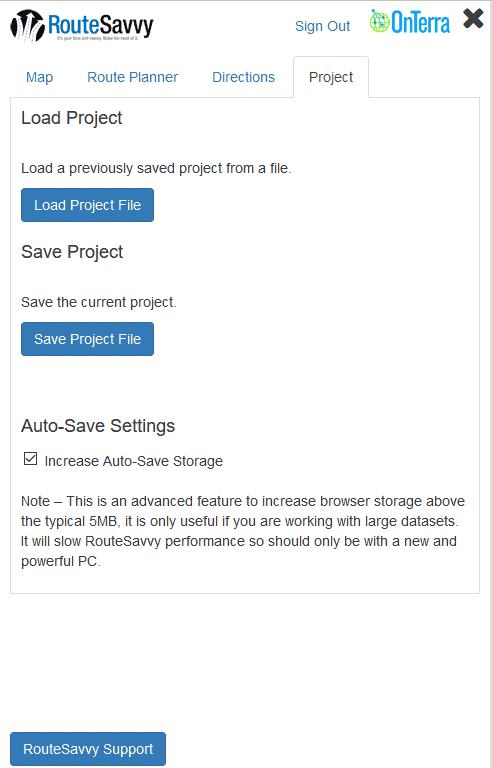
If you have questions, please contact RouteSavvy Support.
